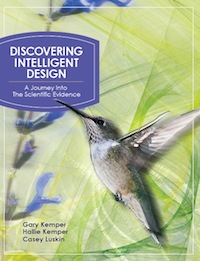 Education
Education
 Intelligent Design
Intelligent Design
Striking the "High Accuracy" and "High Readability" Balance with the New Discovering Intelligent Design Curriculum
 Over the past couple of months, readers may have noticed I haven’t posted quite as many articles here as usual. This is partly because I’ve been working with my co-authors, Gary and Hallie Kemper, to put the finishing touches on a new introductory ID curriculum, Discovering Intelligent Design. (An interview with ENV about the curriculum has already been posted, as well as a description.)
Over the past couple of months, readers may have noticed I haven’t posted quite as many articles here as usual. This is partly because I’ve been working with my co-authors, Gary and Hallie Kemper, to put the finishing touches on a new introductory ID curriculum, Discovering Intelligent Design. (An interview with ENV about the curriculum has already been posted, as well as a description.)
Having written in this space since the end of 2005, I’ve learned a few lessons about science writing. One of the main things I’ve found is that it can be a real challenge to communicate complex scientific concepts to a general audience.
First and foremost, a good science writer needs to make sure what he says is accurate. Then comes the next challenge: communicating those scientific ideas to a diverse readership — not just scientists and university students but bank tellers, hotel clerks, soccer moms, priests, rabbis, gardeners and even my dear old grandma. (OK, maybe not my own grandma in particular — she has no idea how to use the Internet.) And above all, teachers and high schoolers (and not just the nerds and geeks, but also goths, punks, vamps, skaters,…and maybe even the stoners and the jocks).
At this point, there are a couple options.
The “quick and easy path,” as Yoda would say, is to sacrifice scientific accuracy for the sake of communicating to everyone. Another path that can also be easier (but isn’t always the best choice) is to keep your science writing on a very high level, maintaining strict accuracy, but very likely failing to reach a broad spectrum of less-technical readers.
Given a choice between sacrificing accuracy and sacrificing accessibility, I’ve essentially always opted for the latter. That’s because I can’t stomach the idea of being inaccurate for any reason, even in the noble pursuit of informing my readership. (If you’re a reader I’ve sometimes lost, please accept my apologies.)
But what if this choice is really a false dilemma? Perhaps there’s a third way, one that communicates scientific information to a broad spectrum of readers yet remains scrupulously accurate. Indeed, I think there is such a third option. It typically requires a lot more time and effort to craft your material. It also usually requires that the science writer himself have a deeper understanding of the subject at hand, and use creativity so as to better explain the relevant ideas. This third way, in my opinion, is the best .
It is precisely the approach we took in developing Discovering Intelligent Design. My co-authors and I worked very hard to make sure that we covered the core topics in the debate over intelligent design, yet communicated the material at an easy-to-read level that could be understood by advanced middle school or high school students, or any other lay reader.
For more information, check out the curriculum at www.discoveringid.org.
